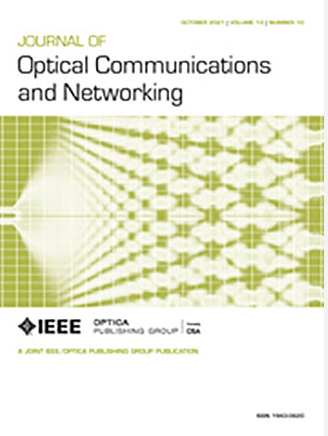光云网络中沉浸式元宇宙体验的多用户延迟同步算法
IF 4.3
2区 计算机科学
Q1 COMPUTER SCIENCE, HARDWARE & ARCHITECTURE
引用次数: 0
摘要
虚拟世界需要用户之间紧密同步的延迟,以确保连贯和沉浸式的多用户交互。然而,由异构云选择和网络路由引起的延迟差异显著降低了协作的质量。为了解决这一多用户延迟同步(MULS)挑战,本文提出了一种基于光云网络(OCN)的多用户云网络协作架构,该架构利用细粒度光传输网络(fgOTN)技术为多用户提供同步和低延迟连接。在此基础上,提出了从延迟同步角度量化用户体验的服务体验模型,并在此基础上设计了共同优化云节点选择和路由策略的多用户延迟同步算法(MULSA)。仿真结果表明,与基准算法相比,MULSA的整体服务体验提高了20% ~ 30%,服务成功率提高了3% ~ 10%。本文章由计算机程序翻译,如有差异,请以英文原文为准。
Multi-user latency synchronization algorithm for an immersive metaverse experience in optical cloud networks
The metaverse demands tightly synchronized latency among users to ensure coherent and immersive multi-user interactions. However, latency discrepancies caused by heterogeneous cloud selection and network routing significantly degrade the quality of collaboration. To address this multi-user latency synchronization (MULS) challenge, this paper proposes a multi-user cloud-network collaborative architecture based on the optical cloud network (OCN), which leverages fine-grained optical transport network (fgOTN) technology to provide synchronized and low-latency connectivity for multiple users. Built upon the proposed architecture, we propose a service experience model to quantify user experience from the perspective of latency synchronization, based on which we design the multi-user latency synchronization algorithm (MULSA) that jointly optimizes cloud node selection and routing strategies. Simulation results demonstrate that MULSA improves the overall service experience by 20%–30% and increases the service success rate by 3%–10% compared to baseline algorithms.
求助全文
通过发布文献求助,成功后即可免费获取论文全文。
去求助
来源期刊
CiteScore
9.40
自引率
16.00%
发文量
104
审稿时长
4 months
期刊介绍:
The scope of the Journal includes advances in the state-of-the-art of optical networking science, technology, and engineering. Both theoretical contributions (including new techniques, concepts, analyses, and economic studies) and practical contributions (including optical networking experiments, prototypes, and new applications) are encouraged. Subareas of interest include the architecture and design of optical networks, optical network survivability and security, software-defined optical networking, elastic optical networks, data and control plane advances, network management related innovation, and optical access networks. Enabling technologies and their applications are suitable topics only if the results are shown to directly impact optical networking beyond simple point-to-point networks.

 求助内容:
求助内容: 应助结果提醒方式:
应助结果提醒方式:


